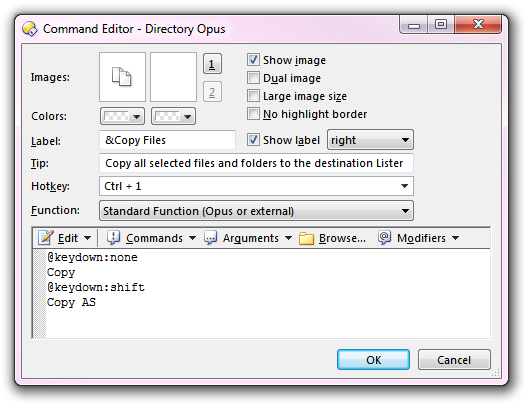
The simple mode only lets you define functions that consist of a single line. From simple mode, click the Advanced button to switch to advanced mode, which lets you create more complex functions. The command editor will switch to advanced mode automatically if the button you are editing already contains a function that extends over more than one line. In the advanced mode the single line Function field is replaced by a multiple-line text box that lets you create more complicated, multiple-line functions.

This screenshot shows the command editor when it is in advanced mode (the function shown is from Copy Files button on the default toolbar). You can see that the single-line Function field has been replaced with a multiple-line field. There is a new drop-down which lets you select the type of the function (Standard or MS-DOS Batch). Also, the Start in and Run fields have disappeared - if they had been specified in simple mode, they will be replaced by equivalent commands in the multi-line function definition.


In these screenshots you can see that the Start in field has been converted to a cd command (to set the current directory) and the Run setting has been converted to a @runmode modifier. There are a number of command modifiers that you can use for commands in advanced mode. Another one is shown above: in the Copy File function, the @keydown modifier is used to change the button's function based on whether the Shift key is held down or not. See the Command modifiers page for more information on modifiers.
The Function drop-down in advanced mode lets you select from two types of functions:
The multi-line text field is where you enter the instructions that make up the command. The toolbar along the top of the field contains a number of drop-downs that can help you build up the command:
Lines beginning with // are ignored, allowing you to put comments in your commands.